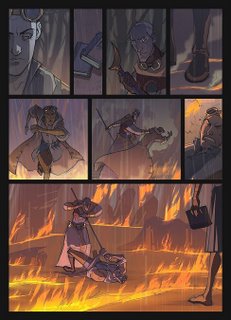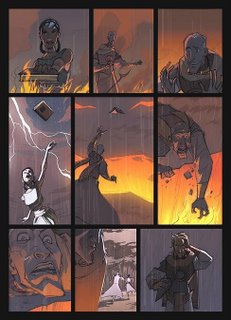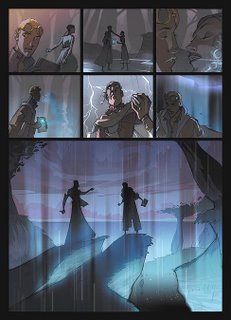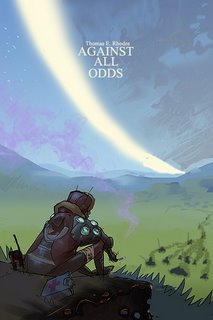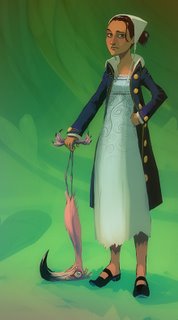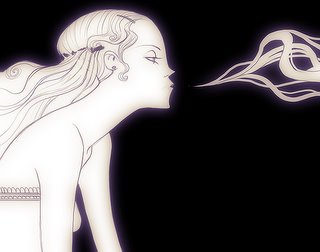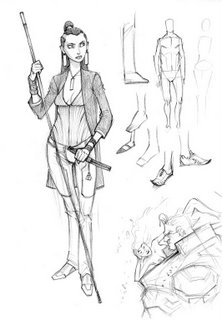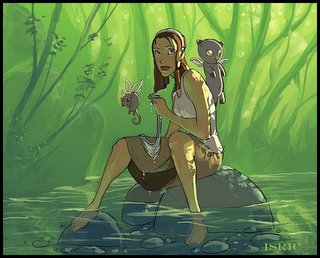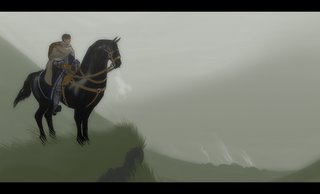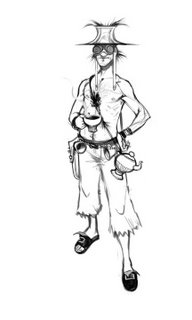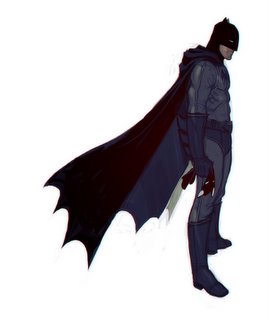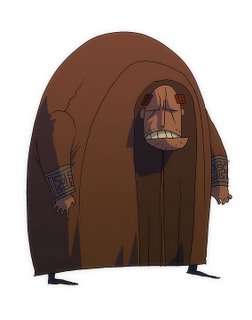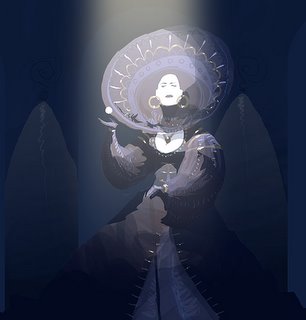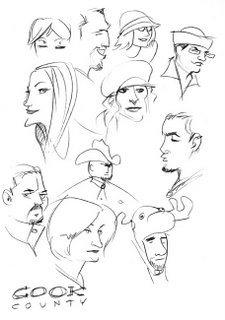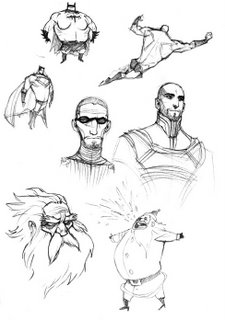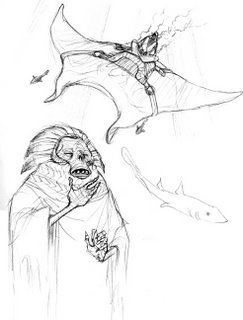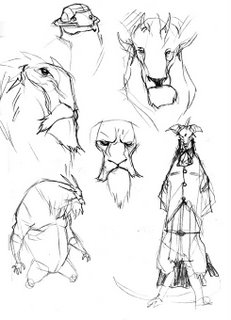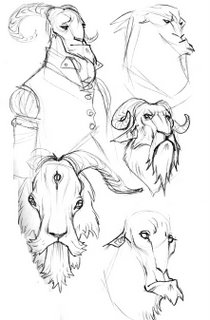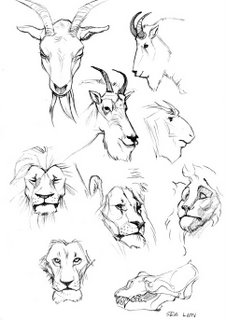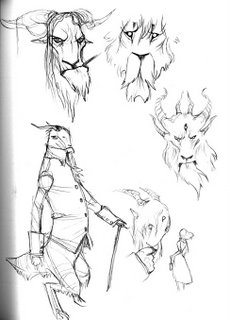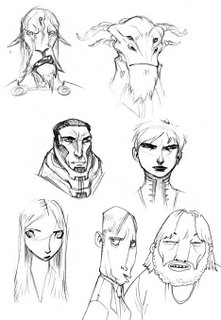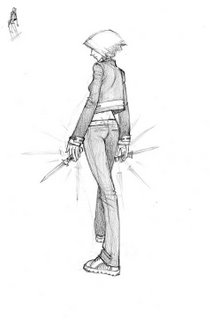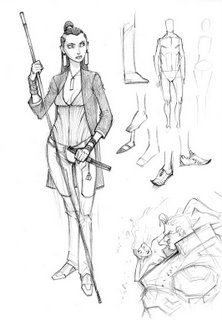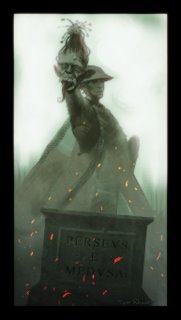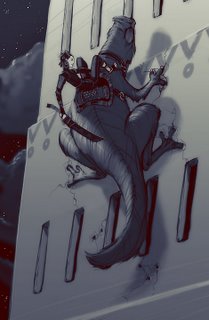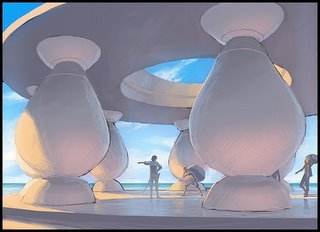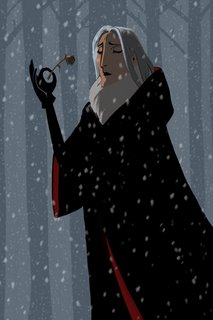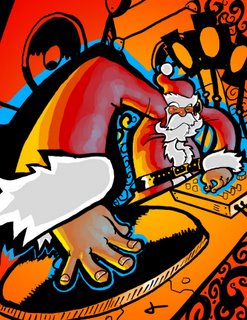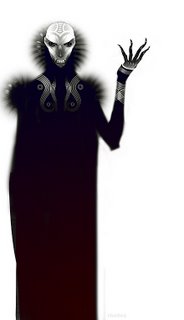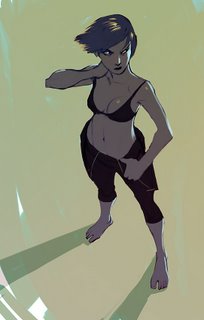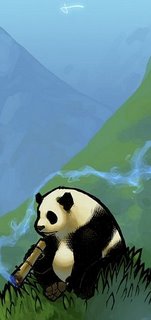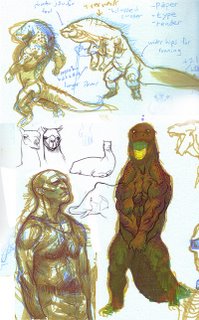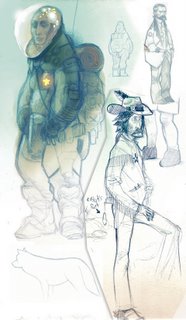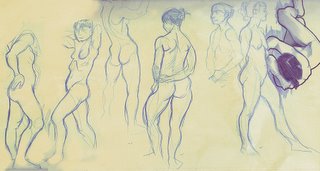RHODES BROTHERS INTERVIEW
Comics, Story Boarding, Books, and Games.
Sunday, November 27, 2005
BROUGHT TO YOU BY THE CHARACTER DESIGN BLOGSPOT
IF YOU WOULD LIKE TO SEE MORE CHARACTER DESIGNERS GO TO THE HOME PAGE BY CLICKING HERE

Tell me a little bit about yourself, about your life? Where did you go to school, and what classes did you study? What helped prepare you to become the artist that you are today?
Matt: We were born and raised in Calgary, Alberta, so during the summer we’d run around outside with sticks and Gi-Joes, and during the 8 month winters we’d sit inside and draw. I ended up at the Alberta College of Art and Design (ACAD), where after four delightful years I pranced out with a Bachelor of Design. We had incredibly supportive parents who backed us up no matter what, as long as we were doing what we loved. Now I work as a Concept Artist at the videogame developer BioWare.
Tom: Yeah we both had a fairly productive childhood. Getting into trouble, staying out of trouble, getting other kids in trouble, that sort of thing. Our parents were amazing, and I would be surprised if I’d still be mad about art if they weren’t so encouraging. But after high school I started at ACAD, and I’m in second year visual communications. I have some time to go but I’ll be out soon enough.
The things that helped us to become the artists we are today would be having awesome role models, and being exposed to really cool stuff when we were young. When other kids were watching Home Alone and Care Bears, we were watching Terri Gilliam movies and Aeon Flux. Looking at the art of others, and aspiring to be as good as those above us were things that never let us quit. I had my Capcom art and Ed McGuiness, Matt had, I don’t know, like Craig Mullins and Tony Diterlizzi, or something, we were always trying to get inspired.
How do you go about designing a character, and what goes through your mind, from start to end?
Matt: To me, a really good character design has to start with a good story. A lot of my personal drawings are fragments of stories. I’ll think of a scene I like, and then come up with the characters to populate it. For work, either in Concept Design or Commission illustration, you have to get inside the characters long before the pencil ever touches the paper. This is still something I’m trying to get better at. Once you know the character (or environment, or animal, or anything), it pretty much draws itself.
Tom: I’m still at the point where school takes up most of my time, and when I do take time to do my own stuff I feel really guilty because I’ not doing homework. So what I do is usually just individual drawings, though I do try and keep a bit of a story to each of them, I feel like its a little pointless when I’m not actually able to create a whole, actual piece. But for an idea of what is typically standard operating procedure, you usually start with research. Think of what drives the person you’re drawing has, why must he look the way he does? How is he a child of his surroundings? Just try and get to know the person. then with those qualifications in a pretty sturdy place, develop a unique silhouette for them to have, give them something you’ve never seen before, make them unique, then fill in the shape with details and objects that tell the story and work with/for the character and then that should probably give you what you want
What do you think really helps you out in designing a character?
Matt: Real Life. I’ve both met and seen people out in the real world that blow my mind. The shapes people can be (especially the shapes people choose through their habits) are so diverse it’s almost scary. It’s taught me that you can pretty much do anything you want, because somewhere, somehow, there’s somebody more ridiculous.
Tom: My shyness growing up. It gave me a lot of time to just sit there and listen to what people were saying, how they were acting, and what certain things about them told you what they were about. It’s just the observation that came into play, and with that, I felt I was able to assess someone's character a little more quickly in my art, and really show people who they were. How someone carries themselves, holds their face, and even the pattern of wrinkles on their face can say a lot about them, and almost everyone intrinsically knows how to read those signs. So yeah, just observation mostly.... and what Matt said.
From your own experience and maybe from some people that you know, what should we put in our portfolio and what should we not?
Matt: Be diverse, but stick to a style. Having recently looked at portfolios, the most interesting ones had consistent style, but covered different subjects. The least interesting ones had all kinds of styles and approaches, but were essentially the same things over and over again. Also, only put in the stuff you actually want to be doing. My portfolio was incredibly self-indulgent, and now I’m paid to draw what I’d be drawing anyway.
Tom: I don’t really have anything to add except that environments are a big part. In my wanderings, someone from a big company told me "everyone and their dog wants to do character design. But if you can do environments, you'll be a lot more interesting to employers." do everything that Matt mentioned, but be sure that environments are in there too and you will be a force to be reckoned with. That’s all I can add, variety is key.
What are some of the things that you have worked on?
Matt: My first real commission (the one I got “all by myself”) was with the author Tad Williams. I was just out of High School, and he asked me if I wanted to be involved in his upcoming project Shadowmarch. Tad had been my favorite author for years (and still is), so I almost shat myself. That was about 5 years ago, so looking back at the drawings fills me with shame, terrible shame, but I had a blast and learned a lot about work. Tad was amazing to work with and I would love to be able to do something with him again, especially now that I’ve learned so much more. Ever since then I’ve worked with various authors, some magazines, kids who saved their allowance, one love-struck guy who needed a special gift for a “friend”, a videogame company here and there. In a lot of ways, now that I’m done school, I feel like I’m starting at Chapter One. Bioware is the first real job I’ve had in the field. I’m 22 years old, so I know the book hasn’t even been written yet.
Tom: I did a bunch of work at an advertising company downtown Calgary, which was a lot of fun. They had me do story boarding, character design, architectural renderings, stuff like that. There were some random art jobs here and there doing character design, coloring, things like that. The only thing really worth mentioning at this point was probably an internship at Orbital Media, a small gameboy game company. It was a huge learning opportunity, and I was being paid to do awesome stuff like animation, environment design, and I was even lucky enough to be able to do the cinematics for their next game coming out. It was really fun, and I got a small taste of what id love to be doing when I’m done school. I plan on working in every major field in "geek media" before I start my own studio, and I think my stint at orbital was a nice start.
Is there a character design you have done that you are most proud of?
Matt: I’ve always been interested by how people react to different images. Some people have loved the ones I thought nothing of, and yawned about the stuff I thought was awesome. So over the years I’ve been conditioned to not let my own opinion of my work see the light of day.
Tom: I have a hard time keeping track of what I’ve done, but so far it’s probably got to be the Unicorn. probably just because one of my friends loved it so much and we started developing a story around him, and I like the look of him and all that. eehhh, its probably just because its the only one I actually remember.
What are you working on now? (If you can tell us)
Matt: Right now I’m doing character design for Bioware’s upcoming game Mass Effect for the X-Box 360. I’m also working on a short 6-8 page comic, but there will be more news on that later. And, on a more long term note, I’m in the process of choosing a story for a slightly longer project. That’s not vague is it?
Tom: For now, only school for me (and a couple of secret thingies).
Where is the place you would like to work if you had a choice?
Matt: I would love to escape the winter for a while, so anywhere the sun shines all year round. I’d like to eventually find myself in California.
Tom: A short list would probably have to be Weta, Industrial Light & Magic, Valve, Bioware, DC comics, Capcom, and a few studios of my own creation which I’d like to start up someday. I want to work everywhere and do everything. Europe, south/west states, Japan, New Zealand would be countries/continents I’d be interested in living in.
Who do you think are the top character designers out there?
Matt: My only hesitation with answering this is that I know I’m going to miss people. There are a lot of pros and a lot of peers that I have admired for years:
Claire Wendling, Ben Caldwell, Reagan Lodge, Joy Ang, Ed Kwong, Ken Wong, Dermot Power, Massimiliano Frezzato, Peter DeSeve, Carter Goodrich, Kevin Dalton, Vera Brosgol, Tim McBurnie, Bengal, Lance King, Dave Curd, Jake Parker, Justin Cherry…
Tom: Yeah it's tough to name these guys without missing a few and feeling like you're breaking a couple hearts. There are so many I would love to give credit for, but also so many I don't even know the names of. But here are some anyway on top of what matt already put:
Jim Henson, Guarnido, tony diterlizzi, caroline delen, alexander stodolnik, adi granov, tek9Z, and so many, many more. I feel kind of dirty for being able to only add a few more to the pile, but I think this is a pretty good place to start none the less.
How do you go about coloring the character, what type of tools or media do you use?
Matt: I’m a Photoshop boy. I used to use other programs, but PS has gradually taken over. The only traditional media I use now are Colerase pencils for sketchbook work. A lot of experienced artists that I admire have denounced purely digital work, and I can understand where they’re coming from. Knowledge of traditional media is essential. But…well…Photoshop is just so damn fast. And clean. And you never run out of yellow paint in the middle of an image. And there are so many tools! And it’s so clean! I never have to wash brushes, and I never have black fingernails! It’s glorious! *puts away his Adobe mug and sweater*
Tom: I love markers. I think markers are my favorite, followed closely by Photoshop. Prismacolor markers, Pantone Tri, Chartpack markers are all my favorite so far. It’s like having Photoshop in your sketchbook. Though... I guess when I buy a laptop I’ll have Photoshop with me anyway, but still, there’s something so satisfying about using markers. And it’s clean (unless they're broken), fast, and it can look great.
The way I go about it usually, is I start with one light color over the whole silhouette of the character, then over it with the proper colors, then I add blemishes and imperfections (i.e. red nose, red cheeks, etc), then its just a matter of filling in areas their proper colors, then I usually overlay certain areas with different colors to tie them together, and then I add more imperfections (grass stains, 5 o'clock shadow, mud, scratches, etc). It’s a really fun process!
What type of things do you love to draw, and why?
Matt: People are the best thing ever. There’s nothing more interesting, worthwhile, or ridiculous. Unfortunately, this means I need to practice my environments. Also, I have kind of a jacket addiction. At any given moment I own more jackets than pants and shoes combined. I’m getting help, taking some pills, but in the meantime it means I love drawing jackets. That’s why most of my characters have coats. They’re wearing what I want in my own closet. Some day, if it’s socially acceptable, I’ll run around in long, high collared coats all day long.
Tom: I like to draw heroes and explorers mostly. Usually taking the form of astronauts, cowboys, or soldiers. I guess you could say the types of things I like to draw are positive male role models and moral ideals. Characters that represent or stand for courage, honor, respect, things like that. Its just manifested in "positive male role models" for boys, and when I actually draw women they’re good strong women that girls can admire (I hope!). They just come out in different forms. Same message, different bottle. To simplify, you could say astronauts, monsters, and soldiers/warriors. ha ha ha! It’s so clich�…
What part of designing a character is most fun and easy, and what is most hard?
Matt: The easy part is drawing it; the hard part is coming up with something convincing to draw. If I stop life drawing, it shows up in my work. Characters start getting stale and I keep drawing the same face over and over. I need to constantly remind myself of the diversity of mankind, so I guess the hard part is trying to stay fresh.
Tom: Yeah definitely. The easy part: drawing it. The hard part: coming up with it. But it's not THAT hard and certain parts of that process are more difficult than others, but really making it convincing is the tricky part. Making something that successfully communicates what you need to get across to tell the story. It takes a balance to achieve that, and I guess that’s what art directors are for, and man, it really helps if you know exactly what the character is like in order to grasp his/her/its essence. (The most fun part is drawing it and even moreso coloring it)
What are some of your favorite character designs and least favorite, which you have seen?
Matt: The Prince of Egypt is my favorite movie of all time, and one of the many reasons is the character design. That movie satisfies me completely. Moses, the Queen, Rameses, Tzipporah, all of them. It’s just a joy to sit and watch them do things. My least favorite is more of a genre. I love certain anime films, and have been inspired by many of them, so I wouldn’t dream of bashing them. I just (personally) can’t watch them anymore.
Tom: some of my favorite designs are batman, civil protection from half-life 2, the monster from the Relic, Darth Vader, storm/clone troopers, the fett family, wolverine. It’s hard for me to think of any good female characters, because most of them are so cliche and typical, but Alyx from half life 2 is a really good one. My least favorite would have to be stuff from mortal kombat, any comic by top cow, or image comics, and stuff by Tim Burton and his followers.
Matt: You leave Burton out of this! His stuff is great!
What is your most favorite subject to draw?
Matt: Long coats, sailboats, heroes and villains, vast places, but mostly just the human face.
Tom: heroes and villains. I find sci-fi, fantasy and genre pieces can be equally awesome settings so long as your characters are cool. But the hero/villain theme is so righteous it can't be ignored.
What inspired you to become a Character Designer?
Matt: I still remember sitting on the couch in my pajamas, trying over and over again to pause Beauty and the Beast at just the right moments, so that I could try to draw the characters. Everything from movies, to the books our parents read to us, there were always these amazing, lifelike characters. Right from the beginning I was fascinated with what seemed like magic: the ability to breathe life into something.
Tom: Bad comics. I remember I was about 12 or 13 when I realized, while looking through a comic, that the guys doing it were not doing a very good job. Black guys were just white guys with brown skin, the artists were repeating the same poses, could only draw faces from certain angles, and all the girls just had a pony tail, red lips, big boots and her midriff showing. It was all just recited, repetitive cliche hog shine. I really didn’t like it, and since then I’ve been trying to make every character different from anything else I’ve done (I hate drawing the same thing twice), and I guess just in doing that I had to learn how to design characters. I’m still learning how to avoid what’s expected and cliche.
What are some of the neat things you have learned from other artists that you have worked with or seen?
Matt: Confidence is so important. I’ve met a lot of artists over the years, and one of the worst things is to find yourself with one of the “oh I’m not very good” artists. Just do what you love, act comfortable and confident, and you’ll do fine.
Tom: Well one interesting tidbit I learned from a guy at orbital was that shadows cast out in the sun are 50% before any radiant lighting is applied, and that's helped in my coloring ability quite a lot. That’s one neat thing I can think of.
What wisdom could you give us, about being a character designer? Do you have any tips you could give?
Matt: Save your best ideas for your own work, but when working for others, try as hard as you possibly can. I’ve only recently learned that everything you do is your portfolio. There have been projects I’ve been less passionate about, and in looking back I wish I had put more effort into them. Try to do work that you’ll be proud of for years to come (even if you don’t think they’re good, you’ll at least be glad you tried).
Tom: Be bold, brave, and blatant. Draw it or don't, and be confident. Research. The more you know about the world around you and beyond, the better an artist you can become. Just study stuff, be fascinated in things, and don’t be afraid to get a little fanatic about the things that interest you. Dig deep, it's a big universe. Oh yeah, and be sure to get a lot of sleep, too.
If people would like to contact you, how would you like to be contacted?
Matt: Email would be great. I always like to hear from people. My email address has been the same since I was in grade 10: in4thehunt@hotmail.com
Tom: yeah, hearing from folk is great. people can get a hold of me at DASUNICORN@GMAIL.COM or thaiboxintom@hotmail.com
Finally, do you have any of your art work for sale (sketchbook, prints, or anything) for people that like your work can know where and when to buy it?
Matt: Not yet, but I understand something is sort of in the works as far as prints go. I’ve also started to think about selling sketchbooks, but I still have to talk to a few people.
Tom: Ditto. If people want to buy stuff or hire either of us, just drop us a line and we can give you more information.
CLICK HERE TO GO BACK TO THE CHARACTER DESIGN HOMEPAGE
Subscribe to:
Comments (Atom)
